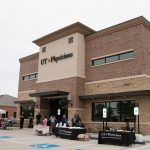Echocardiogram
Imaging the heart: What you need to know
What is an echocardiogram?
An echocardiogram (also called an echo) is a test that uses high-frequency sound waves (ultrasound) to create detailed images of heart chambers, walls/muscles, and valves. These images can also measure the heart’s blood flow and function. Your doctor may use an echo test to look at your heart’s structure and check how well your heart functions.
- No preparation is required.
- There are no recognized harms or side effects.
- The test typically takes 45-60 minutes.
An echocardiogram test can help your doctor determine:
- The size and shape of your heart and the size, thickness, and movement of your heart’s walls
- Your heart’s pumping strength
- If your heart valves are working correctly
- If blood is leaking backward through your heart valves (regurgitation)
- If your heart valves are too narrow (stenosis)
- If there is a tumor or infectious growth around your heart valves
The echocardiogram test can also help determine if there are:
- Problems with the outer lining (pericardium) of your heart
- Problems with the large blood vessels that enter and leave the heart
- Blood clots in the chambers of your heart
- Abnormal holes between the chambers of the heart
What happens during the echo?
- You lie on a table, and a technologist places electrodes on your chest. The electrodes have wires that connect to an electrocardiograph machine. The electrocardiogram (ECG or EKG) keeps track of your heartbeat during your test.
- The technologist puts gel on your chest to help sound waves pass through your skin.
- The probe (transducer) is passed across your chest. The probe produces sound waves that bounce off your heart and “echo” back to the probe.
- The sound waves are then translated into pictures and displayed on a video monitor. The pictures on the video monitor are recorded so your doctor can look at them later.
- The technologist may ask you to move or hold your breath briefly to get better pictures.
- The room is kept dark so your technologist can better see the video monitor.
What happens after the echo?
- Your technologist will help you clean the gel from your chest.
- Your doctor will discuss the results of your test with you, usually at your next appointment.
Other ultrasound-based tests
Stress echocardiography
A stress echocardiogram uses ultrasound to see how the heart works under exercise conditions. Under exercise, this test can tell if there is a reduction in blood flow to the heart muscle due to a blocked artery. We usually use a treadmill, so we encourage patients to wear something comfortable to walk on the treadmill. Preparation requires nothing by mouth (NPO) for at least four hours before the test. Expect the test to last approximately one and a half hours.
Carotid ultrasound
Vascular ultrasound uses sound waves to create detailed images of the carotid arteries. These images can also be used to measure the blood flow through the artery and detect blockages. No preparation is required. Expect the test to last approximately 45 minutes to one hour.
Venous Doppler
Venous Doppler uses ultrasound to evaluate the presence of deep venous thrombosis (blood clot) in the veins of the legs or arms. No preparation is required. Same-day service is generally available, unless specified by the patient or physician. Expect the test to last approximately 45 minutes to one hour.
Ankle-brachial index (ABI)
Ankle-brachial index (ABI) is the ratio of the blood pressure in the lower legs to the blood pressure in the arms. Compared to the arm, lower blood pressure in the leg is an indication of blocked arteries (peripheral vascular disease). No preparation is required. Expect the test to last approximately 45 minutes to one hour.
Arterial duplex
Arterial duplex scan uses ultrasound to evaluate the arteries for stenosis, aneurysm, or wall irregularities or to evaluate stents or bypass grafts. (Single-level ABI will be performed along with duplex). No preparation is required. Expect the test to last approximately 60-75 minutes.
Abdominal aorta screening
Vascular ultrasound uses sound waves to create detailed images of the abdominal aorta. These images are used as a screening method to assess for abdominal aortic aneurysm. Preparation requires nothing by mouth (NPO) after midnight on the night before the test. Please schedule an early morning slot. Expect the test to last approximately 45 minutes to one hour.
Electrocardiogram (EKG)
An electrocardiogram (ECG or EKG) records the electrical signal from your heart to check for different heart conditions. Electrodes are placed on your chest to record your heart’s electrical signals, which cause your heart to beat. The signals are shown as waves on an attached computer monitor or printer.
Heart rhythm monitor
A heart rhythm monitor is a diagnostic test in which the electrical activity of your heart is recorded in order to identify any irregular heart rhythm. Your heart rhythm can be recorded in a number of ways. These monitors, called Holter or event recorders, are small devices that are connected to leads that are placed on the chest to record heart rhythms.
Exercise stress test (also known as treadmill test, exercise test, exercise cardiac stress test, and ECST)
A monitor with electrodes that are attached to the skin on the chest area records your heart function while you walk in place on a treadmill. Many aspects of your heart function can be checked, including heart rate, breathing, blood pressure, ECG (EKG), and how tired you become when exercising.
Echocardiology Centers in Houston, TX
Houston, TX 77030-5206
Mon - Fri 8 a.m. - 5 p.m.
Houston, TX 77059-3656
Mon - Fri 8 a.m. - 5 p.m.
Bellaire, TX 77401-3535
Mon - Fri 8 a.m. - 5 p.m.
Sat 8 a.m. - 12 p.m.
Mon and Wed 8 a.m. - 5 p.m.
Tue and Thu 8 a.m. - 6:30 p.m.
Fri 7 a.m. - 5 p.m.
Sat 8 a.m. - 12 p.m.
If you must cancel or reschedule, please do so at least 24 hours before your appointment.
What happens during the echo?
Echo tests are done by specially trained technologists. The test takes about 45 minutes to an hour.- You lie on a table and a technologist places electrodes on your chest. The electrodes have wires that connect to an electrocardiograph machine. The electrocardiogram (ECG or EKG) keeps track of your heartbeat during your test.
- The technologist puts gel on your chest to help sound waves pass through your skin.
- The probe (transducer) is passed across your chest. The probe produces sound waves that bounce off your heart and “echo” back to the probe.
- The sound waves are then translated into pictures and displayed on a video monitor. The pictures on the video monitor are recorded so your doctor can look at them later.
- The technologist may ask you to move or hold your breath briefly to get better pictures.
- The room is kept dark so your technologist can better see the video monitor.
What happens after the echo?
- Your technologist will help you clean the gel from your chest.
- Your doctor will discuss the results of your test with you, usually on your next appointment.
Other ultrasound-based tests:
A stress echocardiogram uses ultrasound to see how the heart works under exercise conditions. Under exercise, this test can tell if there is a reduction in blood flow to the heart muscle due to a blocked artery. We usually use a treadmill, so we encourage patients to wear something comfortable to walk on the treadmill. Preparation requires nothing by mouth (NPO) for at least 4 hours before the test. Expect the test to last approximately 1 ½ hours.
Vascular ultrasound uses sound waves to create detailed images of the carotid arteries. These images can also be used to measure the blood flow through the artery and detect blockages. No preparation required. Expect the test to last approximately 45 minutes to 1 hour.
Venous Doppler uses ultrasound to evaluate the presence of Deep Venous Thrombosis (blood clot) in the veins of the legs or arms. No preparation required. Same day service is generally available, unless specified by patient or physician. Expect the test to last approximately 45 minutes to 1 hour.
Ankle Brachial Index (ABI) is the ratio of the blood pressure in the lower legs to the blood pressure in the arms. Compared to the arm, lower blood pressure in the leg is an indication of blocked arteries (Peripheral Vascular disease). No preparation required. Expect the test to last approximately 45 minutes to 1 hour.
Arterial Duplex scan uses ultrasound to evaluate the arteries for stenosis, aneurysm, wall irregularities, or to evaluate stents or bypass grafts. (Single level ABI will be performed along with duplex) No preparation required. Expect the test to last approximately 60-75 minutes.
Vascular ultrasound uses sound waves to create detailed images of the abdominal aorta. These images are used as a screening method to assess for abdominal aortic aneurysm. Preparation requires nothing by mouth (NPO) after midnight on the night before the test. Please schedule an early A.M. slot. Expect the test to last approximately 45 minutes to 1 hour.
An electrocardiogram (ECG or EKG) records the electrical signal from your heart to check for different heart conditions. Electrodes are placed on your chest to record your heart’s electrical signals, which cause your heart to beat. The signals are shown as waves on an attached computer monitor or printer.
A heart rhythm monitor is a diagnostic test in which the electrical activity of your heart is recorded in order to identify any irregular heart rhythm. Your heart rhythm can be recorded in a number of ways. These monitors, called Holter or event recorders, are small devices which are connected to leads that are placed on the chest to record heart rhythms.
A monitor with electrodes that are attached to the skin on the chest area records your heart function while you walk in place on a treadmill. Many aspects of your heart function can be checked, including heart rate, breathing, blood pressure, ECG (EKG), and how tired you become when exercising.





